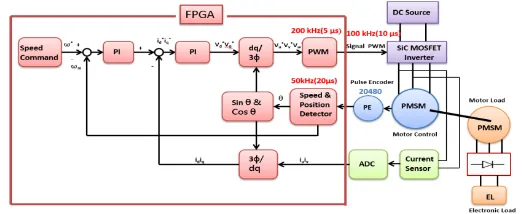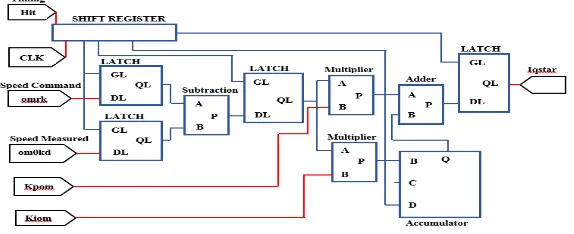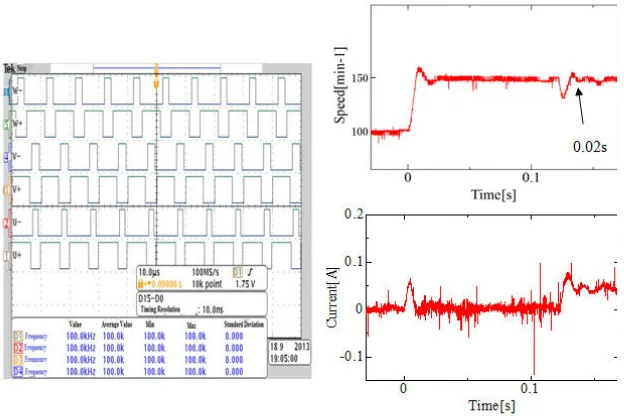! "
# $ % &
'( )( * ) * + , )( *( - . / ( * 0 .
1Graduate School of Life Science and Systems
Engineering Kyushu Institute of Technology, 2 4 Hibikino, Wakamatsu ku, Kitakyushu 808 0196, Japan
*Corresponding Author: [email protected]
This paper proposes a digital hardware control of Permanent Magnet Synchronous Motor (PMSM) using a SiC MOSFET inverter implemented in a FPGA (Field Programmable Gate Array) device. High frequency is required using a SiC MOSFET inverter to obtain high response and good stability for speed control systems. Not only the switching frequency of inverter, but also the control frequency is achieved up to 100 kHz for speed control system of AC motor drive including vector control and dq transformation. As the result, high response control system of PMSM can be achieved. Digital hardware control based on FPGA is used to maximize the switching frequency of SiC MOSFET inverter. Finally, an experimental system is set up and some experimental results are demonstrated.
Keywords: Speed control, High frequency, SiC MOSFET inverter, FPGA, PMSM.
Dv Viscous damping coefficient, N.m/rad/s motor is nowadays preferred in a variety of applications [3].
A high performance motor control system requires a high response system and recovery to steady state condition immediately when a motor is loaded and influenced by any disturbances. To achieve it, the high frequency PWM is needed so the speed control system using FPGA with SiC inverter is proposed. There are many advantages of using high frequency PWM (in range of 50 to 100 kHz) in motor drive applications. High motor efficiency, fast control response, lower motor torque ripple, close to ideal sinusoidal motor current waveform, smaller filter size, lower cost filter, etc. are a few of the advantages [4].
There are many published studies that have given attention to achieve a high response control system in the speed control of a permanent magnet synchronous motor. Zhou [5] proposed an FPGA realisation of a speed servo controller of PMSM. Ying [6] proposed a speed control integrated circuit (IC) for permanent magnet synchronous motor (PMSM) drive under this SoPC environment. Then, an adaptive fuzzy controller is adopted to cope with the dynamic uncertainty and external load effect in the speed loop of PMSM drive.
2
This paper proposes the use of SiC MOSFET based inverter in the speed control of permanent magnet synchronous motor. High response system is achieved by using SiC MOSFET in this research so that the motor can recover to steady state value as soon as possible. It takes only 0.02 s to reach the steady state value. Because the processing speed gets faster, software control principally has a calculation time limitation. FPGA is used for speed and torque control because high speed calculation is obtained using the ability of the hardware processing [7].
Voltage equations of PMSM are derived in two axis d q synchronous rotating is d/dt. The electromagnetic torque can be simplified to equation (2).
=
λΦ =(2) where λ is the number of pole pairs of motor; Φais armature flux; kt is torque coefficient; iq is q axis current. The dynamic equation of PMSM can be written as
in equation (3).
SiC devices such as MOSFETs offer the benefit of efficient power conversion in areas that current Si based power semiconductors do not [9]. The inverter presented in this paper is designed by using SiC MOSFET for switching component and Schottky Barrier Diode (SBD) is connected in parallel with each SiC MOSFET to reduce the switching loss and specifically the reverse recovery loss [10]. SBD offers a number of advantages such as low turn on voltage, fast recovery time, and low junction capacitance. The inverter topology is shown in Fig. 1.
" ! " # " #
$ " !
% # & # '
( S2 S4 S6 V0
S1 S4 S6 V1
S1 S3 S6 V2
S2 S3 S6 V3
) S2 S3 S5 V4
* S2 S4 S5 V5
+ S1 S4 S5 V6
, S1 S3 S5 V7
The carrier wave comparison method is used to generate a PWM pulse. A carrier wave is shown in Fig. 3. A carrier wave is made by counting up/down counter (200 MHz). The circuit generating carrier wave is shown in Fig. 4. There are 1000 up/down counters implemented in FPGA. A control period is synchronised every half cycle. In this research, frequency of PWM is 100 kHz and control frequency is 200 kHz.
" & ! " ) & !
) - "
.
$
"
/
The control method of PMSM is a vector control employed for variable speed control systems. The speed commands are sent to control blocks which include three PI controllers for speed control and two current control loops, dq and inverse dq coordinate transformation. Then, a PWM pulse generator is produced for switching of inverter. Rotor position and motor angular speed are detected and calculated from a pulse series generated from an incremental pulse encoder which is mounted on the rotor axis of the PMSM.
3
performance FPGA based digital hardware controller is used to implement the speed control of a permanent magnet synchronous motor. FPGA is used for the torque and speed control in some cases because a fast processing operation is obtained using the ability of the hardware processing.
Figure 5 shows a proposed digital hardware control system for the speed control system of PMSM by using FPGA. FPGA (XILINX Spartan3E XC3S1600E) is used to control the speed control of PMSM.
" * 0 1 2 - " 0 /
Program algorithm is written in VHDL [11]. VHDL is a hardware description language that describes the behaviour of an electronic circuit or system, from which the physical circuit or system can be implemented. Multipliers, adder, and subtraction are employed for the calculation. A timing generator is used to generate timing of operation. It also generates a control signal, sampling signal of Analog to Digital Converter and speed detector. The signals connect to modules and manage the control period, sampling period of encoder and input/output data timing of the peripheral device.
Figure 6 shows speed and position detector circuits implemented in the FPGA which consists of a counter, latch and multiplier. The speed should be the same units as the speed command value of the speed command block. The speed sampling pulse that indicates the speed detection circuit is a signal generated by the timing generator. Rotor positionθ is obtained using an Up/Down counter. In the FPGA sinθ/cos θ can be obtained by using a look up table.
-There are three PI (Proportional Integral) controllers used for both speed and current control. In the PI controller, each variable has a 32 bit data to keep precision. Figure 7 shows the hardware system of a PI speed controller which consists of shift register, latch, subtraction, adder and multiplier. Calculation of the PI speed controller circuit is performed in the order of timing calculation provided by the shift register. Deviation of the measured value with the command value is taken by the first subtraction. Deviation is latched in each control cycle by the calculation timing which is multiplied by the gain at the next timing. The accumulator is a circuit which performs an integration operation.
" , 0
The current detector circuit is used to create a signal for controlling the AD converter. It is necessary to provide adequate signal to each pin of the AD converter. It is also necessary to create a current signal using a 1 bit data to perform serial communication using an AD converter. Figure 8 shows a time chart of the AD converter operation. AD conversion is begun in accordance with the rising edge of the CS signal. Therefore, it is necessary to capture the output signal of the AD converter at the rising edge of the CLK. A current 12 bit signal is created by using a 12 bit shift register. The detail of the signals is shown in Table 2.
Figure 9 shows the design of a current detector which consists of a D flip flop, shift register and counter. The signal from the current detector circuit will be sent to the AD converter. The timing (Hit) is used for the timing generation circuit, and converted into 12 bit shift register parallel signals. Figure 10 shows a dq coordinate transformation circuit. The operation of the dq coordinate transformation is to convert uvw coordinates into αβ coordinates and convert αβ coordinates into dq coordinates. Phase currents are converted to dq axis for space vector control. Interface used in this research is shown in Fig. 11.
" 3
4- !
-5
" "
0 0 " - !
Start of conversion to digital values from the analog value
Signal of conversion start 6 CLK signal is sent to the AD converter Clock Signal
- 1 bit Data is sent from the AD Converter Output Signal
" "
Minimum Positive or Negative CS Pulse Width 4 ns Min
Setup Time After CS↓ 6 2000 ns
SDO Enabled Time After CS↓ 4 ns Max
) SDO Data Valid Access Time After SCK↓ 15 ns Max
* SCK Low Time 40%(tSCLK) Min
+ SCK High Time 40%(tSCLK) Min
, SDO Data Valid Hold Time After SCK↓ 5ns Min
3 SDO Into Hi Z State Time After SCK↓ 5 14 ns
5 SDO Into Hi Z State Time After CS↑ 4.2 ns Max
6 Shift Clock Frequency 0.5 48 MHz
.' %7. % Minimum Throughput Time, tACQ + tCONV 333 ns Max
# Conversion Time 277 ns Min
8 Acquisition Time 56 ns Min
8% SDO Hi Z State to CS↓ 4 ns Min
" ( 9
0 7 : +(( ;) 7 ( % " /
< " % % ! %
Total No. Slice Registers 1775 29504 6%
Number of Occupied Slices 2730 14752 18%
Total Number of 4 input LUTs 4635 29504 15%
Number of bonded IOBs 26 250 10%
Number of Block RAM 33 36 91%
Number BUFGMUXs 14 24 58%
Number of DCMs 2 8 25%
*
=0
'
*
=0
0
The proposed experimental system is depicted in Fig. 12 and the PMSMs used for experiment are shown in Fig. 13. Two types of PMSMs are used for the control system, one is for the motor and the other is for the load. Both of them are connected via coupling. Encoder is mounted on the rotor axis of the PMSM. The FPGA used for experiment is shown in Fig. 11.
" 7 " =0 00
7
*
=0
Figure 14 shows the PWM for switching of an inverter seen on the screen of an oscilloscope. 100 kHz is achieved using FPGA. FPGA is the best way of designing a digital PWM generator. Time resolution is 10 ns. U, V, and W phases are seen on the screen for each positive and negative value. Each phase has a phase difference of 2π/3 from each other. Furthermore, PWM has a dead time processing for delaying between the gating signals of the top and bottom devices in an inverter leg to prevent a short circuit of a DC link. 0.5 Rs dead time is achieved using FPGA.
Figure 15 shows a step response of the proposed system. The speed command is changed from 100 min1 to 150 min1. The speed decreases when the motor is loaded and recovered to the steady state condition immediately. It takes only 0.02 s to reach the steady state value. The q axis current is equivalent to the motor torque and the current increases when the motor is loaded. The results are obtained by using a clock frequency of FPGA which is set to 48 MHz and encoder pulse is 20480 ppr. The PWM switching frequency is achieved up to 100 kHz. The control frequency is achieved up to 200 kHz and only when the frequency of a speed detector is 50 kHz. Experimental results show the feasibility of a high performance system of PMSM speed control system using FPGA.
" ) & " * 0 ' 0
0 0 /
+
the switching frequency of an inverter up to 100 kHz. FPGA can be used to ensure fast processing operation in a high frequency switching of an inverter.
'
1. Shen, M.; and Krishnamurthy, S. (2012). Simplified loss analysis for high speed SiC MOSFET inverter. IEEE Applied Power Electronics Conference and Exposition, 1682 1687.
2. Kamel, H.M.; Hasanien, H.M.; and Ibrahim, H.E.A. (2009). Speed control of permanent magnet synchronous motor using fuzzy logic controller. IEEE Electric Machines and Drives Conference, 1587 1591.
3. Advan, B.; Kuppuswamy, A.; Jayabaskaran G.; and Jagannathan, V. (2011). Field oriented control of permanent magnet synchronous motor (PMSM) using fuzzy logic controller. IEEE Recent Advances in Intelligent Computational System, 587 592.
4. Shirabe, K.; Swamy, M.; Kang, Hisatsune, J.K.; Wu, M.Y.; Kebort, D.; and Honea. J. (2012). Advantages of high frequency PWM in AC motor drive applications. IEEE Energy Conversion Congress and Exposition, 2977 2984. 5. Zhou, Z.; Li, T.; Takahahi, T.; and Ho, E. (2004). FPGA realisation of a high
performance servo controller for PMSM. IEEE Applied Power Electronics Conference and Exposition,3, 1604 1609.
6. Kung, Y. S.; and Tsai, M. H. (2007). FPGA based speed control ic for PMSM drive with adaptive fuzzy control. IEEE Transaction on Power Electronics, 22(6), 2476 2486.
7. Hanamoto, T.; Deriha, M.; Ikeda, H.; and Tsuji, T. (2008). Digital hardware circuit using FPGA for speed control system of permanent magnet synchronous motor. Proceeding of the ICEM, 1 5.
8. Bose, B.K. (2002). Modern power electronics and AC drives. Upper Saddle River, NJ: Prentice Hall PTR
9. Lai, R.; Wang, L.; Sabate, J.; Elasser, A.; and Stevanovic, L. (2012). High voltage high frequency inverter using 3.3 kV SiC MOSFETs. International Power Electronics and Motion Control Conference, 1 5.
10. Shen, M.; Krishnamurthy, S.; and Muldhokar, M. (2011). Design and performance of a high frequency silicon carbide inverter. IEEE Energy Conversion Congress and Exposition, 2044 2049.


